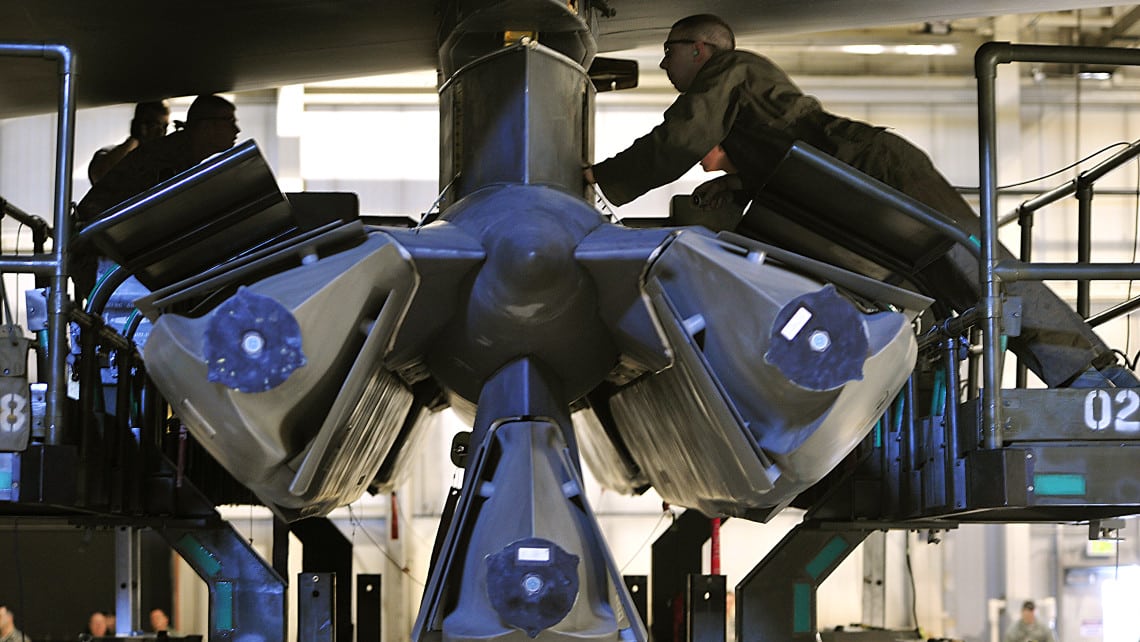The U.S. Air Force awarded a much-anticipated contract for the Long Range Strike Bomber (LRSB) last month, a critical platform to support both conventional missions and nuclear deterrence. Much remains to be done to deliver a nuclear-capable LRSB on budget and on schedule. Beyond the LRSB and the B61-12 gravity bomb life extension, however, modernization of the aging air-breathing leg of the nuclear triad requires an investment in a future cruise missile.
A nuclear cruise missile is the weapon most commonly associated with extended deterrence across the Asia Pacific’s tyranny of distance. When the nuclear sea-launched Tomahawk (TLAM-N) was retired, Asia-Pacific allies in the region were reassured in part by the continued U.S. capability to quickly forward-deploy nuclear weapons on aircraft, especially with air-launched cruise missiles. The only current nuclear cruise missile is the AGM-86B ALCM, carried aboard B-52 bombers. First deployed in 1982 with a planned service life of 10 years, the ALCM is insufficiently stealthy for modern air defenses, and its reliability continues to decline. The planned but still-nascent replacement for the ALCM is known as the Long Range Standoff missile, or LRSO.
Recently, some commentators have attacked the LRSO as unnecessary, destabilizing, and expensive and have called for LRSO to be cancelled entirely. Such a step would reduce the air-delivered leg of the triad to gravity bombs alone, betting that the LRSB stealth characteristics will forever defeat future air defenses. Eliminating the LRSO would also undermine the administration’s current “3+2” plan for the future stockpile (3 missile warheads and 2 air-delivered weapons), reducing it to “3+1.”
At base, these are arguments against the desirability of nuclear-armed cruise missiles as such. In some cases, the arguments against LRSO are coupled with hopeful (but groundless) suggestions that unilateral U.S. elimination will prompt others to follow suit, perhaps even inspiring a global ban. On the contrary, the flexibility and credibility of a delivery system like LRSO may well represent one of the most important components of a twenty-first- century deterrent tailored not to Cold War requirements but to more limited and discrete scenarios.
There are no signs that the long-established military requirement for a nuclear-capable standoff cruise missile will diminish. On the contrary, trends suggest it may become more important than ever.
As affirmed in the 2010 Nuclear Posture Review (NPR), bomber-delivered cruise missiles have unique characteristics. LRSO would preserve and enhance attributes largely not available elsewhere, including signaling, mass, the mitigation or avoidance of overflight of third parties, the potential for recall, and the ability to reach multiple targets simultaneously. A bomber with gravity bombs alone has to fly more or less over each target, one at a time—making air defense easier for an adversary and increasing the risk not only to the bomber and its pilot, but also to the crews of associated tanker and fighter aircraft.
Another underappreciated characteristic is cruise missiles’ potential for circuitous paths. Unlike with an intercontinental ballistic missile (ICBM), for example, an adversary would not know in advance from which direction the “multi-axis ingress” missile may come. Given the uncertainty, adversaries would have to invest significantly more in air defenses (a cost-imposing strategy), or simply accept vulnerability. Besides flying around air defenses, cruise missiles can also strike from different angles, which may be helpful, say, to reach targets dug into the far side of a mountain.
Nor would a newer nuclear cruise missile be at odds with the vision expressed in Prague. President Obama’s 2009 speech committed to sustaining a safe, secure, and effective nuclear force for as long as nuclear weapons exist. The 2010 NPR and the 2013 update to the nuclear employment guidance reaffirmed the need to retain air-delivered weapons as part of the larger triad. The stabilizing features of cruise missiles were likewise recognized in the counting rules for the administration’s signature arms control agreement, New START.
Cancelling LRSO would be a significant reduction of flexibility, and one not to be taken lightly. Like the ALCM, LRSO will be around a long time, providing flexibility and meaningful options to presidents not only in this decade but those of future decades as well.
To be sure, Russian cruise missiles have garnered much attention of late, both those in violation of the Intermediate-Range Nuclear Forces (INF) Treaty and others that are not. The reasons for a nuclear cruise missile in the U.S. force, however, should and do stand on their own merits.
Last year, Under Secretary of Defense (and chairman of the Nuclear Weapons Council) Frank Kendall warned appropriators that “without LRSO’s advanced stand-off capability, the bomber leg of the Triad will gradually become a symbol of our decline rather than a bellwether of enduring American strength.”
Cruise missiles provide unique characteristics for nuclear deterrence, including capabilities critical to credibility and flexibility in the strategic environment of the twenty-first century. Reducing the bomber’s nuclear mission to gravity bombs alone might retain the skeleton of a triad, but in practice it would undermine rather than strengthen deterrence.
